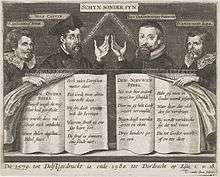Antony van der Does
Antony van der Does (alternate spellings of first name: Anthony and Antonie) (Antwerp, 1609 – Antwerp, 1680) was a Flemish engraver and print maker.[1]

Life
Some 19th-century art historians believed that Antony van der Does was a native of The Hague in the Dutch Republic and was related to the van der Does family of painters.[2] Antony was, however, born in Antwerp where he was baptized on 10 March 1609. There are no indications of a family link with the Dutch van der Does family.[1]

Antony van der Does commenced his study of engraving as a pupil of Jan Collaert II in 1627. In 1633 he was admitted as a master in the Guild of Saint Luke of Antwerp. In 1634 he married Anna du Pont, the sister of Paulus Pontius, one of the leading engravers in Rubens’ studio.[3]
Work
He had a reputation for his engraved portraits. He sometimes used the monogram "AVD".[3] HIs style is regarded as close to that of Paulus Pontius.[2]
He also engraved historical and mythological scenes after the work of the leading Antwerp painters of the time such as Rubens, Anthony van Dyck, Erasmus Quellinus II, Gaspar de Crayer and Abraham van Diepenbeek.[3]
He worked on various publication projects for leading publishers in the Southern Netherlands and the Dutch Republic. He was in 1642 in Brussels making some of the plates for the 'Portraits des hommes illustres du 17e siècle' (Portraits of famous people of the 17th century) a publication released in Amsterdam in 1649.[2] Some of these plates have the date 1649.
He made for the publisher Joannes Meyssens various portraits for his publication projects. He was, for instance, responsible for the engraving of the portraits of the painter Leonaert Bramer and the engraver Jacob Matham in Het Gulden Cabinet, a publication of Meyssens authored by Cornelis de Bie.[4]

He made around 1650 a print satirizing the publication of different bible editions by the Dutch Calvinist lbrecht Hendriksen in Delft in 1579 and the Dutch New Reformed Church minister J. Canin in Dordrecht in 1580. The print was used by the Flemish Catholic polemicist Aernout van Geluwe in his book the Vlaemschen boer (Flemish Peasant) published in Antwerp in 1652. The print shows Aernout of Gheluwe pulling a curtain on the left revealing the Old Bible of John Calvin and another on the right revealing the New Bible of the New Reformed preacher.[5]
References
- Antony van der Does at the Netherlands Institute for Art History (in Dutch)
- Arnold van der Does, in: François Brulliot Zeller, Dictionnaire des monogrammes, marques figurées, lettres initiales, noms abrégés etc. avec lesquels les peintres, dessinateurs, graveurs et sculpteurs ont désigné leurs noms, Volume 2, 1817, p. 824 (in French)
- Antonie van der Does (Biographical details) at the British Museum site
- Het Gulden Cabinet on Flandrica.be (in Dutch)
- Satirical Print on the Protestant Bible Publications of 1579 and 1580 at the Rijksmuseum site (in Dutch)
External links
